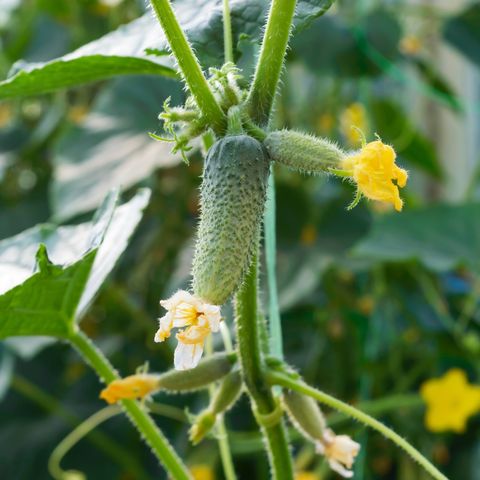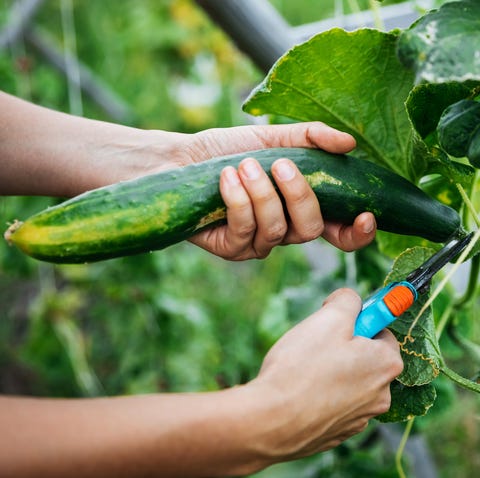One of the joys of growing a summer garden is slicing up a cucumber straight off the vine and savoring that first crisp, cool bite. The goal: to grow a bounty of cucumbers with sweet, refreshing flavor. But sometimes, no matter how hard you try, they’ll taste bitter.
Stressed plants are more likely to develop this unfortunate taste, but the degree of bitterness depends on the severity of the stress. Generally speaking, stress is often caused by insufficient and uneven moisture, but temperature extremes and poor nutrition can also play a part. Minimize stress and maximize flavor by following these steps when growing cucumbers:
1. Keep Your Cucumbers Hydrated
Provide cucumber plants with plenty of moisture, especially during the flowering and fruiting process. Any water stress during this period of rapid growth causes levels of bitter-tasting compounds to rise. Cucumbers are vigorous growers and therefore need between 1 and 2 inches of water per week, depending on the weather and type of soil. The key is to keep the soil slightly moist at all times. Water deeply about once or twice a week — and more often if you’re gardening in sandy soil.
2. Add Mulch to Your Cucumber Bed
To further reduce water stress, surround cucumber plants with mulch to conserve and moderate moisture levels while blocking out weeds. Just wait until summer or after the soil has warmed above 70°F before applying organic mulches such as straw.
3. Regulate the Temperature
Cucumbers like warm conditions, but growing cool and tasty cukes in the heat can sometimes be a challenge. In fact, high temperatures not only affect fruit quality, but they can cause plants to produce more male flowers. FYI: Female flowers produce fruit; male flowers typically appear first and then drop off.
“Cucumbers are really sensitive to high heat,” says horticulturist Emily Gatch, greenhouse and pathology coordinator with New Mexico-based Seeds of Change. “It can be really hard on plants if temperatures are consistently in the mid-90s.” If you’re growing cucumbers in a hot climate, Gatch recommends providing plants with filtered afternoon shade to help cool things down, either by strategically planting taller crops at the southern end or by adding a shade cloth to block 40 to 50% of the sunlight.
4. Give Cucumber Plants Sunlight and Good Soil
For the best-tasting fruit and optimum yields, grow plants in a sunny spot and in warm, fertile, and well-drained soil rich in organic matter with a soil PH between 6 and 7. If possible, plant cucumbers in a raised bed or container garden to ensure that soil drains properly. Wait to sow seeds or set out transplants until after all danger of frost has passed and the soil has warmed to at least 60 degrees — typically two weeks after the last frost. You can start seeds indoors three to four weeks before your anticipated planting date outdoors.
5. Fertilize Cucumber Plants
Plants are heavy feeders, so be sure to feed the soil with rich compost or aged manure. After the vines develop runners and the first flowers appear, follow up with a side dressing of compost, aged manure, or fertilizer once a month.
When your plant’s leaves turn yellow, it’s a sign that they need more nitrogen. To do so, give cucumber plants extra space — literally. FYI: Trellised plants should be planted 8 to 12 inches apart, space bush varieties should be planted 3 feet apart in all directions, and hills with one or two seedlings should be planted about 3 feet apart, with rows 4 to 5 feet apart.
6. Get Rid of Weeds
The best way to protect your cucumbers from pests, like cucumber beetles, is to frequently weed the surrounding area. Weeds can be hosts for bacterial wilt disease, which is spread by cucumber beetles. Over time, these beetles can kill a cucumber plant, especially if it’s already stressed due to poor water, sun, or soil conditions.
7. Use Row Covers
Row covers, hotcaps (or plastic milk cartons with the caps removed), and plastic tunnels are great for getting your cucumber garden up and running. Not only do row covers help plants grow faster and flower sooner, but they also protect plants from pests. Just be sure to remove any covering once plants start to flower.
8. Grow Flowers Nearby
Like people, plants get by with a little help from their friends. Cucumbers need to be pollinated to produce, so plant pollinator-friendly flowers nearby. If you don’t attract pollinators, you’ll likely get cucumber flowers, but no fruit or oddly-shaped fruit.
Different Cucumber Varieties to Plant
Some common cucumber varieties contain compounds known as cucurbitacins that cause fruit to taste bitter. When placed under stress, cucurbitacin levels increase, causing an unpleasant bitter taste. Here’s some good news: You can prevent bitterness altogether by selecting various cucumber types that contain a certain gene that prevents cucurbitacins from forming. These long, very slender, seedless specimens, which may be marked as “burp-less,”are typically sold shrink-wrapped with plastic to protect their thin skins.
Keep in mind that different cucumber varieties grow best in certain conditions. For example, Pick-a-Bushel, Parisian Gherkin, and Salad Bush are all compact bush varieties, so they should be planted in raised beds or mulched gardens. Diva, Martini, and Straight Eight are vining cucumbers that creep along the ground or climb a trellis.
Not sure which variety to plant this year? Try some of our favorite picks in your garden:
- Holland Hothouse (64 days from planting to maturity): A Dutch greenhouse type that can be grown outdoors; these bitter-free and burp-less cukes have a cool and sweet taste. For straight fruits, trellis the vines.
- Marketmore 97 (55 days): Developed at Cornell University, it’s a bitter-free slicer and disease-resistant.
- Tyria (56 days): Another Dutch greenhouse type, producing lightly ribbed, dark green fruits up to 14 inches long. Harvest between 10 and 12 inches long for best flavor.
- Amira (55 days): Middle Eastern type; sweeter flavor than most with a crunchy texture; thin-skinned fruits best harvested at 4 to 5 inches.
- Cool Breeze (45 days): A French cornichon type (small cucumbers meant for pickling); smooth skins; sweet and crunchy flesh with great flavor; harvested when 4 to 5 inches long; sets fruit without pollination.
- Diva (55 days): Smooth, thin, no-peel skin; distinctly tender, crisp, and delicately sweet; best picked at 4 to 5 inches.
- Orient Express (64 days): Flavorful, Eastern type with thin-skinned, dark green fruits; vines very tolerant to disease.
- Sweet Marketmore (62 days): Disease-resistant vines produce consistently in hot or cool weather; great flavor without the burp.
- Tasty Green (65 days): Very tasty with sweet and juicy dark green, slender fruits; can be grown inside or out.
- Armenian (60 days): Also known as snake melon; does well in hot weather. Long, slender light green fruits are spineless and almost always curved, unless grown on a trellis and harvested when 12 inches long. The fruit is somewhat sweet, with a mild, slightly citrusy flavor.
- Socrates (52 days): Does well in cooler conditions; can be grown indoors in locations that stay between 50 to 82°F; dark green, thin-skinned fruit are sweet, tender, and seedless.
How to Harvest Cucumbers
Depending on the variety, cucumbers are ready for harvest 50 to 70 days after planting. You can expect longer harvests of top-quality cukes if you pick the fruits frequently and before they get too large.
The size at which you harvest depends on the variety grown. For optimum taste and texture, American slicers are generally best when harvested at 6 to 8 inches long; Middle Eastern types such as Amira should be picked at 4 to 6 inches; most picklers at 3 to 5 inches; and Asian varieties at 8 to 12 inches.
To harvest, simply grasp the fruit and cut the stem with a pruning or kitchen shears a quarter-inch above it. You can keep harvested cucumbers in the refrigerator for 7 to 10 days. But it’s not a one-and-done deal: The more you harvest, the more fruits your cucumber plant will product, so keep picking ’em!
This content is created and maintained by a third party, and imported onto this page to help users provide their email addresses. You may be able to find more information about this and similar content at piano.io
Source: Home Ideas - goodhousekeeping.com






